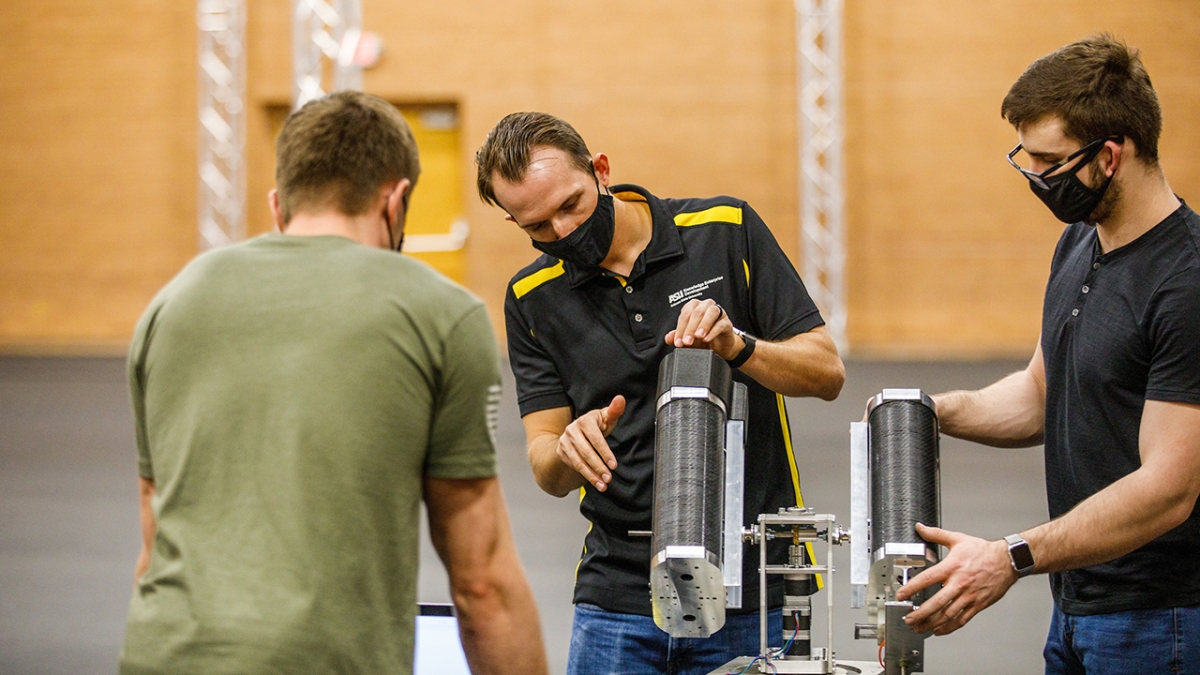With a pop, the flash of a small round something makes a graceful arc against a starry sky. But it’s not the cork from a bottle of celebratory Champagne. Nor is it a baseball after a home run hit.
It’s a probe. And if all goes according to plan, its launcher will hurl it not across Earth, but the moon.
VELOS, short for Variable Exploratory Lunar Observation System, is a specially designed launcher and probe system created by a team of Arizona State University students from the Luminosity Lab. The group is one of eight university teams that NASA named as finalists last spring in its Breakthrough, Innovative, and Game-changing (BIG) Idea Challenge.
“A competition like this is basically the first step on the road map that NASA has built to advance projects, which is really awesome.”
— Tyler Smith, associate director of the Luminosity Lab and staff adviser to the student team
The challenge asks teams to design a technology system that can aid scientific exploration of the moon’s permanently shadowed regions. Finalists received funding to build and test their ideas. The ASU team, along with the others, submitted its final report to NASA this week. The students will present their design to a panel of judges at the virtual BIG Idea Challenge forum planned for early 2021, with NASA announcing the winner at the end of the event.
Making it into the finals means that the students get the chance to work with NASA and industry experts as well as the project’s faculty adviser, Professor Jim Bell of the School of Earth and Space Exploration, who has worked extensively on NASA exploration missions.
“This competition was an amazing chance for these students to learn about the process of getting an idea from the drawing board into a potential deep-space application,” Bell said. “Because of the pandemic, it's also been invaluable practice in working as a distributed, virtual, interdisciplinary team. That experience has been doubly important for them because not only is this how much of the commercial space industry is operating these days, it's how much of the global space industry operates even during normal times.”
In addition, it opens the door to submitting for further NASA funding opportunities, said Tyler Smith, associate director of the Luminosity Lab and staff adviser to the student team.
“A competition like this is basically the first step on the road map that NASA has built to advance projects, which is really awesome,” he said. Regardless of whether their team wins, the students plan to continue advancing their concept.
Ancient moon popsicles
NASA’s challenge focused on the moon’s permanently shadowed regions because they are difficult to study, yet could have vital impact on the future of space travel.
These areas, called PSRs, are craters located at the moon’s poles that never see sunlight. That’s because the moon spins nearly perpendicular to the sun, so these depressions at the top and bottom are never angled toward it.
Not only are PSRs very dark, they’re also incredibly cold. In fact, PSRs are the coldest places in the entire solar system. NASA’s Lunar Reconnaissance Orbiter, an observation satellite that circles the moon, recorded a temperature of -397 F in one of the moon’s south pole craters — even colder than Pluto.
The extremes of PSRs make them difficult to explore. Many rovers rely on solar power for energy, which is unavailable in these regions, and electronics fail at these cold temperatures without a source of heat. However, finding and using a successful solution to these problems could have a huge payoff. Data from the Lunar Reconnaissance Orbiter suggests that there could be water stored as ice within these PSRs.
So why do scientists care about some ancient moon popsicles? If PSRs really do hold water, that water could be extremely useful. It could sustain human and plant life on an extended moon mission. It could also be a fuel source, since separating and recombining water’s hydrogen and oxygen creates energy. This would be handy not only for astronauts staying on the moon, but also for a longer interplanetary mission. A rocket could leave Earth with less fuel — and therefore more spare weight for extra equipment — and refuel on the moon, just like stopping at a gas station.
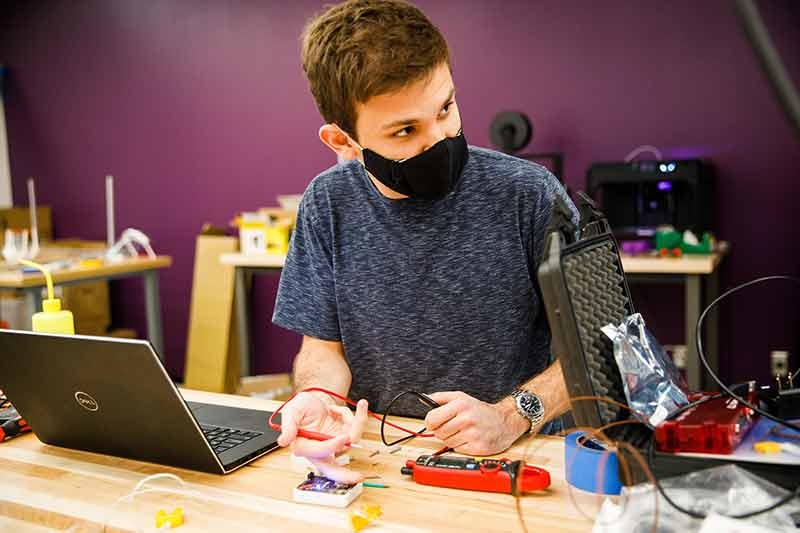
Electrical engineering junior and current team lead Collin Schairer works on the probe’s electronics. Photo by Andy DeLisle/ASU
A giant Nerf launcher
The NASA competition requires the entire system to weigh under 15 kilograms, because it’s expensive to send things to space. The Luminosity team’s solution was to create something disposable.
“Really the only data we need to collect is whether or not there is water in the crater. A device doesn't have to come back. Just the data. The data doesn't weigh anything, and we can more easily retrieve that than retrieve the whole system,” said Collin Schairer, an electrical engineering junior and the current team lead.
They decided to create a set of four small probes that would be sent out by a launcher.
“It’s basically like a giant Nerf launcher,” said Gowan Rowland, a mechanical engineering senior who worked on the design and mechanical build of the system. “It's a spring-loaded assembly. All the stored energy that launches the probe is in a compressed spring.”
Here’s how it works: The launcher, attached to the moon lander, will send out three probes at different distances from the lander in the direction of a PSR. Each probe carries equipment to measure the temperature of the surface it lands on, its acceleration as it lands and which elements are present in its surroundings. Taken together, this data will tell scientists about the environment inside the PSR, including whether it contains ice.
If the three probes are unable to send their information back to the launcher for some reason, it will send out the fourth probe, which will collect and transmit the other probes’ data as it flies above them.
Each softball-sized probe will fly at roughly the same velocity as a regular softball thrown by a person. The special electrical equipment inside them can’t stand the frigid temperatures of a PSR for very long, so the team had to find some of the best insulation in the solar system.
Surrounding the probe’s aluminum shell is a series of fabric and plastic sheets called multilayer insulation that will keep the interior warm enough to operate for as long as possible. The outermost layer is beta cloth, which NASA has used on space suits as well as the Mars Curiosity rover and the International Space Station. It’s made of Teflon-coated fiberglass and is a popular choice for outer space protection because it’s durable, insulating and fireproof.
“I jokingly refer to it as the world’s most expensive baseball sweater,” Schairer said.
Thinking beyond the BIG Idea Challenge, the team wanted to create something that could be applied to a variety of experiments and environments. Their simple, effective design is intentionally scalable and modular so that other science teams can adopt VELOS to their needs, whether that be using more probes, taking other kinds of measurements or deploying it on other moons or planets.
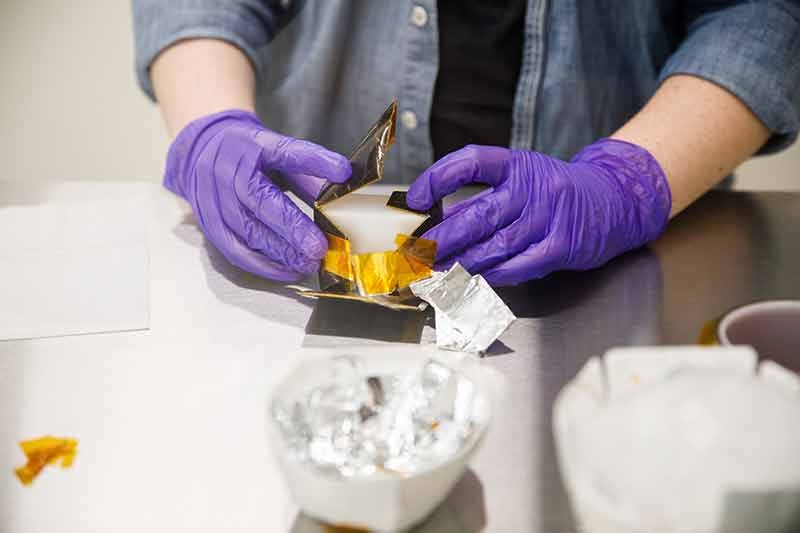
Material science and engineering sophomore Julia Greteman assembles the internal multilayer insulation that protects the probe’s electronics. Photo by Andy DeLisle/ASU
Testing, testing …
To make sure their system is moon-ready, the students put it through multiple tests, both in computer simulation and, leading up to their report submission, real-world experiments.
To test the heartiness of their probe design and ensure it won’t break on impact, they launched it onto a hard rubber surface that’s less yielding than the moon dust researchers have studied so far. (Although we’ve yet to examine moon dust from the polar regions, and variations exist, our present knowledge is that it’s typically very fine, somewhat like the flour in a household pantry.) The probe performed so well, Rowland said, that the team may use less material on the probe’s shell in future design iterations to make it lighter.
The students collaborated with the ASU Interplanetary Initiative to conduct two other tests that need special equipment.
“Space is obviously really cold; space is also a vacuum. So we wanted to test those very harsh conditions,” said Julia Greteman, a sophomore in material science and engineering who helped select and test the materials used in the VELOS design. “The battery is our weakest link, so we're trying to verify that it will be OK for this purpose.”
Using a vacuum chamber, the team placed their probes in a very low-pressure environment to simulate the moon (which has no atmosphere and is surrounded by a vacuum) in order to see how it impacted the battery’s performance. They also put their probes through thermal testing by using liquid nitrogen to quickly cool them and then taking them back out.
The students also made use of the ASU Drone Studio, a new, indoor motion-capture facility belonging to the Ira A. Fulton Schools of Engineering. The space is equipped with cameras that can track objects as they fly through the air — perfect for testing the launcher and calibrating the spring strength needed for the appropriate launch distance in low gravity.
On top of the pressure to create an out-of-this-world technology system, the team also faced the unforeseen hurdle of the COVID-19 crisis, which came about just weeks after NASA announced them as finalists.
“That's been a big challenge for us through this whole process, because Luminosity tends to be a very collaborative group of people,” Schairer said.
Group brainstorming sessions with students scribbling frantically on whiteboards and windows had to be replaced with virtual meetings. To keep the sense of collaboration strong, however, each sub team on the project met biweekly, ensuring that communication continued flowing. For the necessary lab testing, the team limited the number of people present and followed ASU’s preventative COVID-19 guidelines.
“It's not ideal, but we've made it work,” Schairer said. “I'm really proud of the work that we've done since February.”
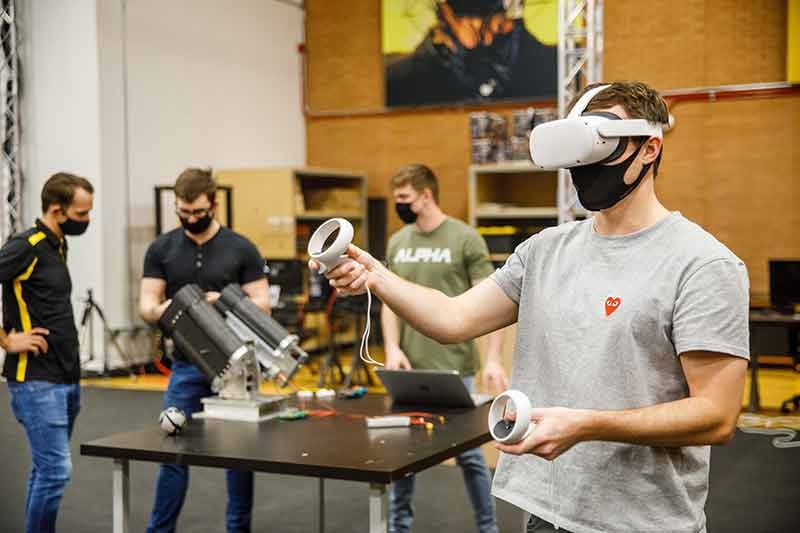
Digital culture master’s degree student and VR development team lead Dylan Kerr explores the team’s virtual reality environment inside the ASU Drone Studio. Photo by Andy DeLisle/ASU
Moon walk, virtually
As if designing a mission-ready space instrument during a pandemic wasn’t enough, the team included a surprise with their final report submission— an educational virtual reality application to go with their project.
The program puts viewers on the moon as astronauts. They can go to different stations on the lunar surface, where they learn about PSRs and how the system works, watch the lander touch down, see the launcher in detail, hold a probe and even hit a button to manually launch a probe. Although the actual system would operate autonomously on a real mission, this program gives a hands-on experience so viewers can better understand the design and its goals.
“I think it’s a unique opportunity for storytelling to provide someone a first-person experience of this project on the moon, given that obviously no one is going to be able to see it like that,” said Dylan Kerr, a digital culture master’s degree student who led the team that developed the VR environment.
Although he admits that they’re hoping to wow the judges, Kerr notes that it could serve as an engaging learning tool for the general public as well. A run-through of the VR experience is available to watch below or on YouTube.
Video by Dylan Kerr and the Luminosity Lab
All of the planning, designing, building, coordinating, testing and presenting that this complex project required has given the team a unique level of preparation for life after graduation, their mentor notes.
“Competing in a NASA project and learning about the methods, standards and traditions used by successful NASA engineers is helping to provide an important foundation for potential future careers in aerospace,” Bell said.
Taken as a whole, it’s not hard to see why this project involved over a dozen students from multiple backgrounds: industrial design, programming, robotics, materials science and electrical engineering, to name a few. That collective approach, said Schairer, made the team much more effective than any one of them could have been on their own.
“That's kind of the point of Luminosity — being able to rely on everyone's strengths and tackle a complex problem with creative solutions.”
The ASU team is scheduled to present VELOS to the competition judges on Jan. 7 at 3:10–4:10 p.m. Eastern Standard Time during the publicly livestreamed 2020 BIG Idea Forum. Any changes to the schedule will be posted to the BIG Idea livestream link prior to the forum.
This project is funded in part by the Arizona Space Grant Consortium, whose mission is to expand opportunities for Americans to learn about and participate in NASA's programs by supporting and enhancing science and engineering education, research and outreach and by delivering high-quality public education programs.
The Luminosity Lab and the Interplanetary Initiative are partially supported by Arizona’s Technology and Research Initiative Fund. TRIF investment has enabled thousands of scientific discoveries, over 950 patents, 328 startup companies and hands-on training for nearly 39,000 students across Arizona’s universities. Publicly supported through voter approval, TRIF is an essential resource for growing Arizona’s economy and providing opportunities for Arizona residents to work, learn and thrive.
Top photo: (From left) Andrei Marinescu, Tyler Smith and Gowan Rowland calibrate the launcher inside the ASU Drone Studio. Photo by Andy DeLisle/ASU
More Science and technology
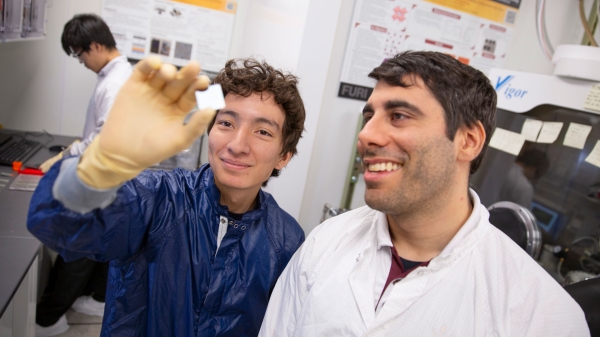
ASU student researchers get early, hands-on experience in engineering research
Using computer science to aid endangered species reintroduction, enhance software engineering education and improve semiconductor material performance are just some of the ways Arizona State…

ASU professor honored with prestigious award for being a cybersecurity trailblazer
At first, he thought it was a drill.On Sept. 11, 2001, Gail-Joon Ahn sat in a conference room in Fort Meade, Maryland. The cybersecurity researcher was part of a group that had been invited…

Training stellar students to secure semiconductors
In the wetlands of King’s Bay, Georgia, the sail of a nuclear-powered Trident II Submarine laden with sophisticated computer equipment juts out of the marshy waters. In a medical center, a cardiac…
